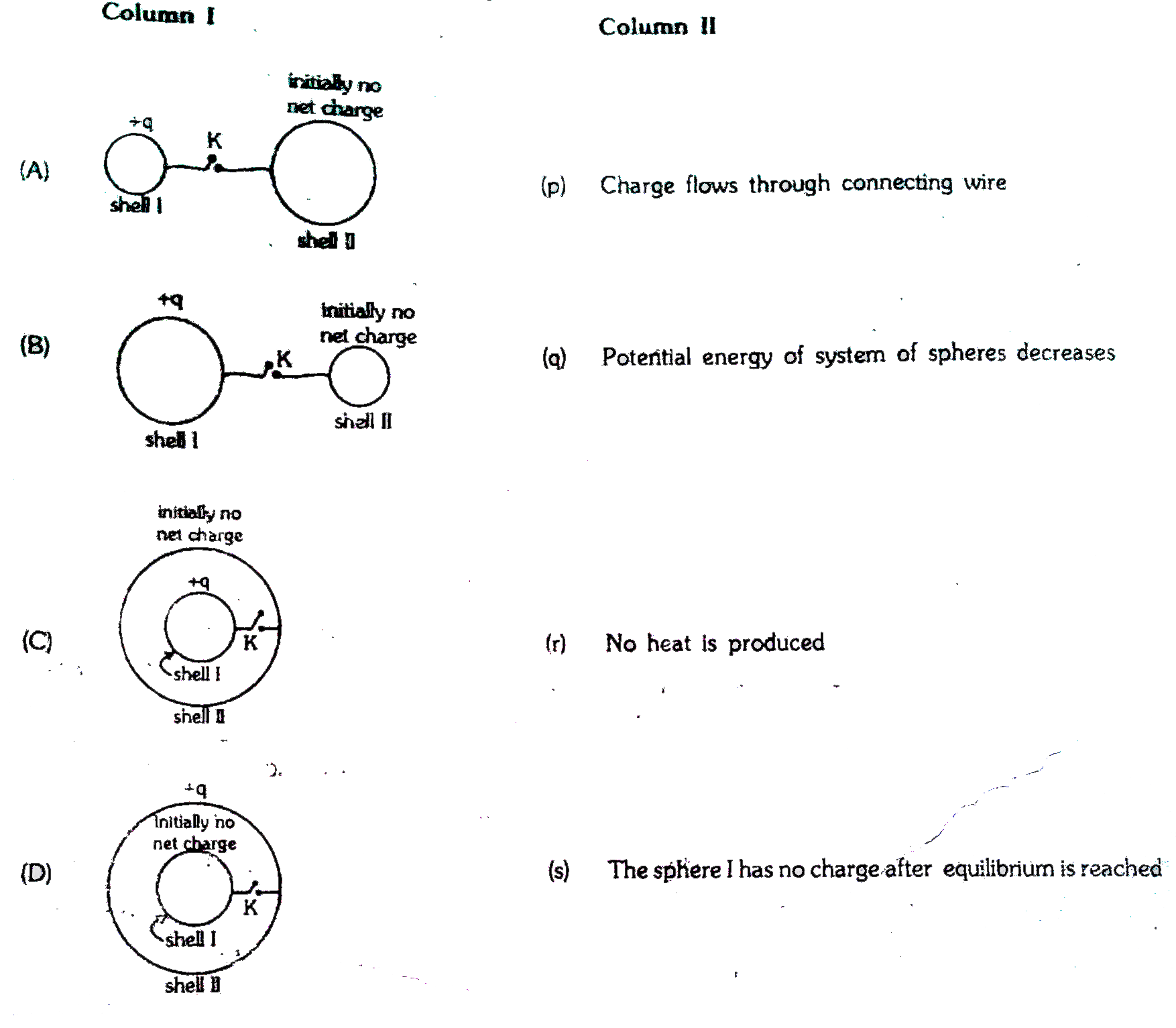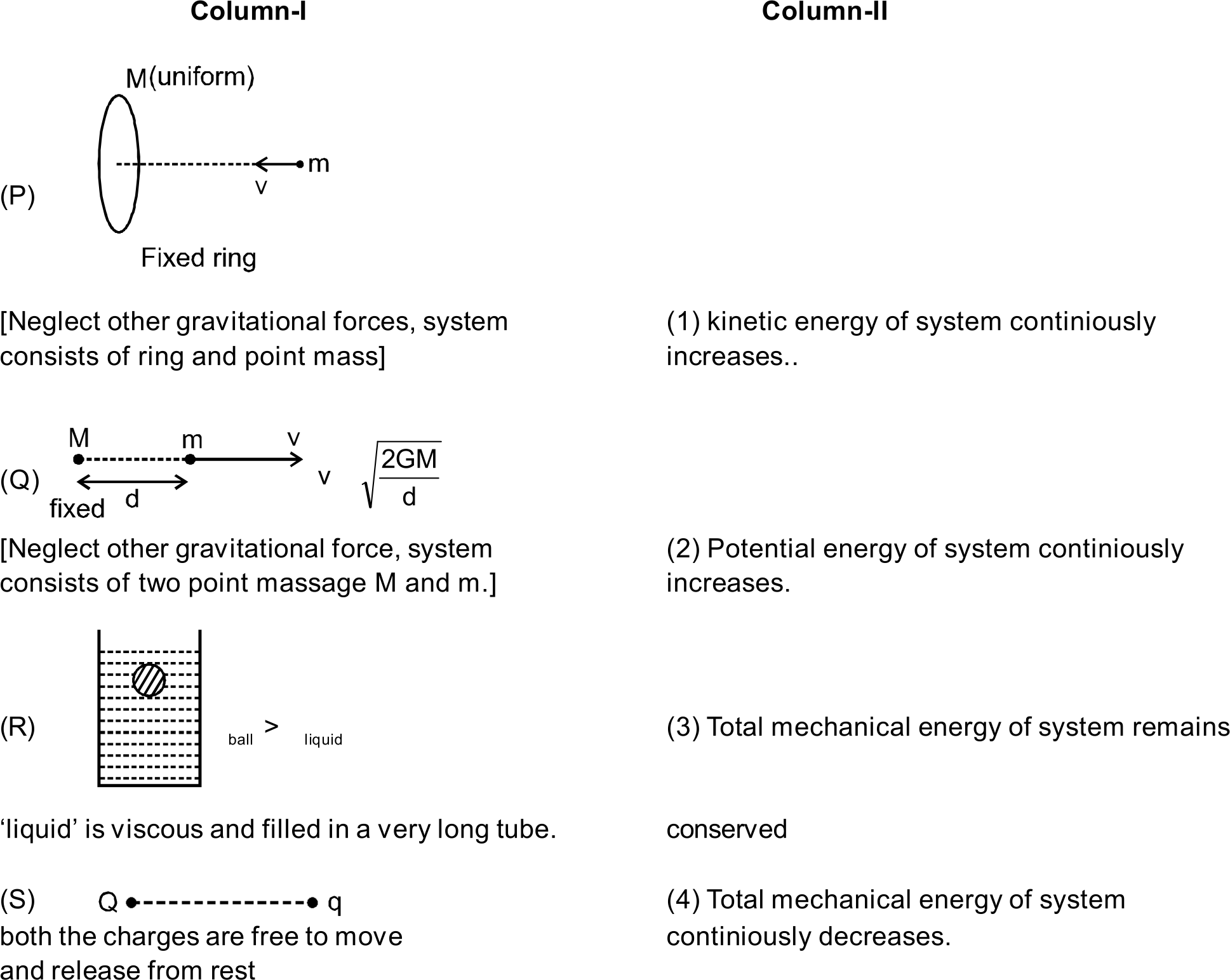Column - I gives certain situtations involving two thin conducting shells connected by a conducting wire via a key K. In all situations one sphere has net charge +q and other sphere has no net charge. After the key K is pressed, Column - II gives some resulting effect. Match the figures in Column - I with the statements in Column - II.

The correct Answer is:A, B, C, D
Topper's Solved these Questions
- ELECTROSTATICSBOOK - AAKASH SERIESCHAPTER - ELECTROSTATICSEXERCISE - PRACTICE SHEET (EXERCISE -IV ELECTRIC POTENTIAL & POTENTIAL ENERGY) (LEVEL - II (ADVANCED) INTEGER TYPE QUESTIONS)
2 Videos
- ELECTROSTATICSBOOK - AAKASH SERIESCHAPTER - ELECTROSTATICSEXERCISE - PRACTICE SHEET (EXERCISE -V ELECTRIC DIPOLE) (LEVEL - I (MAIN) STRAIGHT OBJECTIVE TYPE QUESTIONS)
4 Videos
- ELECTROSTATICSBOOK - AAKASH SERIESCHAPTER - ELECTROSTATICSEXERCISE - PRACTICE SHEET (EXERCISE -IV ELECTRIC POTENTIAL & POTENTIAL ENERGY) (LEVEL - II (ADVANCED) LINKED COMPREHENSION TYPE QUESTION)
2 Videos
- ELECTROMAGNETICSBOOK - AAKASH SERIESCHAPTER - ELECTROMAGNETICSEXERCISE - ADDITIONAL EXERCISE
6 Videos
- ELEMENTS OF VECTORSBOOK - AAKASH SERIESCHAPTER - ELEMENTS OF VECTORSEXERCISE - QUESTIONS FOR DESCRIPTIVE ANSWERS
9 Videos
Similar Questions
Column-I gives certain situations involving two thin conducting shells connected by a conducting wire via a key K. In all situation one sphere has net charge +q and other sphere has no net charge. After the key K is pressed, column-II gives some resulting effect.

View SolutionColumn-I gives certain situations involving two thin conducting shells connected by a conducting wire via a key K. In all situation one sphere has net charge +q and other sphere has no net charge. After the key K is pressed, column-II gives some resulting effect.

View SolutionColumn I gives certain situations involving two thin conducting shells connected by a conducting wire via a key K. In all situations, one sphere has net charge +q and other sphere has not net charge. After the key K is pressed, column II gives some resulting effects. Match the figures in Column I with the statement in Column II.

View SolutionColumn I gives certain situations involving two thin conducting shells connected by a conducting wire via a key K. In all situations, one sphere has net charge +q and other sphere has not net charge. After the key K is pressed, column II gives some resulting effects. Match the figures in Column I with the statement in Column II.

View SolutionTwo wire each carrying a steady current I are shown in four configurations in Column I. Some of the resulting effects are described in column II. Match the statements in Column I with the statements in Column II.

View SolutionThe circuit involves two ideal cells connected to a 1μF capacitor via a key K. Initially the key K is in position 1 and the capacitor is charged fully by 2V cell. The key is then pushed to position 2. Column I gives physical quantities involving the circuit after the key is pushed from position 1. Column II gives corresponding results. Match the statements in Column I with the corresponding values in Column II.

Column I Column II(A) The net charge crossing the 4 volt cell in μC is(p) 2(B) The magnitude of work done by 4 Volt cell in μJ is(q) 6(C) The gain in potential energy of capacitor in μJ is (r) 8(D) The net heat produced in circuit in μJ is (s) 16
View SolutionThe circuit involves two ideal cells connected to a 1μF capacitor via a key K. Initially the key K is in position 1 and the capacitor is charged fully by 2V cell. The key is then pushed to position 2. Column I gives physical quantities involving the circuit after the key is pushed from position 1. Column II gives corresponding results. Match the statements in Column I with the corresponding values in Column II.

Column I Column II(A) The net charge crossing the 4 volt cell in μC is(p) 2(B) The magnitude of work done by 4 Volt cell in μJ is(q) 6(C) The gain in potential energy of capacitor in μJ is (r) 8(D) The net heat produced in circuit in μJ is (s) 16
View SolutionColumn I gives a situation in which two dipoles of dipole moment pˆi and √3pˆj are placed at origin. A circle of radius R with centre at origin is drawn as shown in figure. Column II gives coordinates of certain positions on the circle. Match the statements in Column I with the statements in Column II.

View SolutionColumn I gives a situation in which two dipoles of dipole moment pˆi and √3pˆj are placed at origin. A circle of radius R with centre at origin is drawn as shown in figure. Column II gives coordinates of certain positions on the circle. Match the statements in Column I with the statements in Column II.

View Solution
Column-I has some statements about the system shown in column-II, match appropriate column.
View Solution
